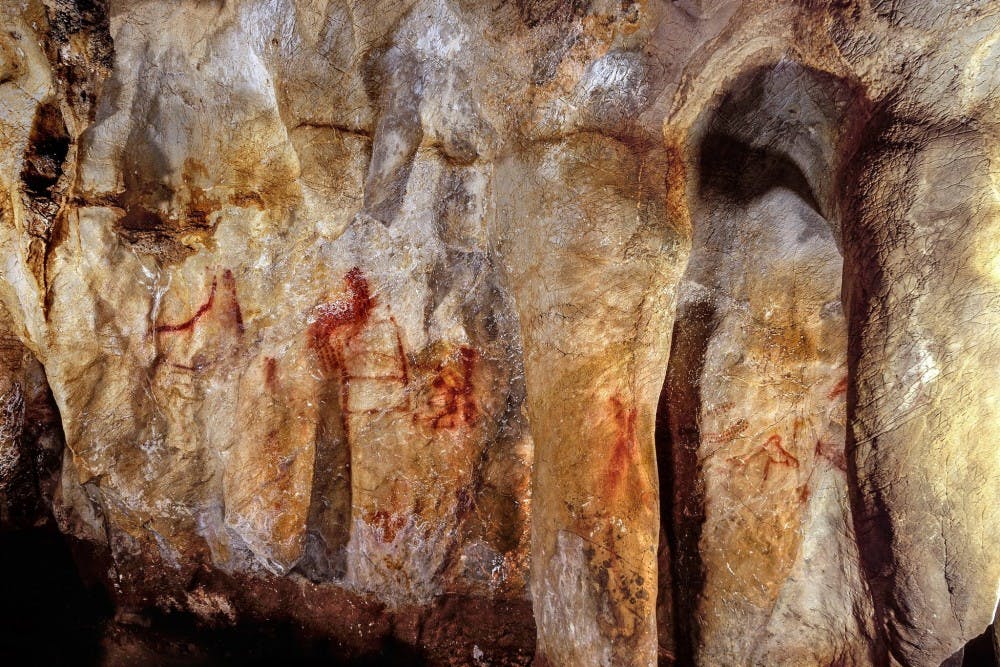From the construction of the ancient pyramids of Egypt to the Colossus of Rhodes to the terracotta army, archaeologists are constantly amazed by what humans thousands of years ago were capable of accomplishing in the absence of modern-day technology.
Recently, archaeologists discovered the creators of newly found cave paintings over 64,000 years old. The artists behind the pieces are actually Neanderthals, a species of archaic humans that might be more intellectually advanced than people have previously believed.
The fossils of Neanderthals were first discovered in 1829 in present-day Belgium. Over the years, scientists have come to believe that this species lived between 40,000 and 400,000 years ago in Europe, with their historical footsteps spanning all the way from Siberia to Spain.
While the Neanderthals’ existence did at one point chronologically overlap with that of modern humans, modern humans did not make their first appearance in Africa until about 45,000 years ago, when they first began to migrate into Europe. Five thousand years after the migration, people belived that Neanderthals had disappeared completely from the surface of the planet.
Scientists still dispute whether Neanderthals should be classified as their own species, namely the Homo neanderthalensis, or whether they should be categorized as a sub-species of Homo sapiens.
The DNA of Neanderthals is 99.7 percent similar to that of modern humans. That makes them closer related to humans than chimpanzees, who are humnans’ closest living cousins with a DNA correspondence rate of 98.8 percent.
Additionally, Neanderthals had a very similar body structure to that of the modern human, except for a few distinct features. Namely, Neanderthals had a much shorter and stockier build, shorter limb proportions and larger noses. They also had a very distinct low, thick brow ridge that was evident on their skulls.
Since their initial discovery in the 1800s, Neanderthals have often been portrayed as monkey-like barbarians that are inferior to modern-day humans. After all, they went extinct while the branch of modern humans continued to survive and thrive. However, further discoveries made since then have led us to believe that these creatures were in fact closer to the intellect of modern humans than researchers had previously believed.
Recent findings have shown that, in addition to the ability to craft and use tools for hunting and survival, Neanderthals were also capable of more abstract, creative thinking.
While we have known about the ancient cave paintings in Spain for years, scientists have had a hard time dating these creations. Radiocarbon dating is often the method to do so, but it only works when the subject of focus contains a carbon-bearing material, such as charcoal.
In addition, the method is often inaccurate for objects over 40,000 years old. However, scientists have found another way to date their findings. This new method involves flowstones, a crusty mineral material created from deposits of water. Flowstone contains uranium, which, over time, breaks down into thorium. The more thorium present, the older the subject is.
Using this method, scientists now believe that the famous paintings in the La Pasiega Cave in Spain are at least 64,000 years old — too old to have been made by modern humans. According to scientists, the artists must have been the Neanderthals.
Scientists have also used this form of dating on rocks near shell jewelry. The rocks turned out to be over 100,000 years old, proving that Neanderthals also had the creative capacity to make jewelry.
Therefore, it is now nearly certain that Neanderthals began making jewelry about 45,000 years before the modern human and made cave art about 24,000 years before, even though the two species existed at the same time.
According to João Zilhão, an archaeologist at the University of Barcelona and co-author of the study, these results imply that we can consider Neanderthals primitive humans.
It is now hard to state that these creatures were inferior to modern humans.
With this surprising discovery, the archaeological studies of ancient times continue as we begin to learn more and more about life thousands of years ago.
While some may question the significance of these types of studies in comparison to scientific advances, junior biomedical engineering major and history minor Nicholas Sass shared his opinion on why it is important for these studies to continue.
“Ancient history is important because it gives us a sense of place about where we came from and how we arrived at where we are today,” Sass said in an interview with The News-Letter. “Knowing our origin is both uplifting and profoundly humbling — a perspective that is invaluable not only to policy makers, but to intellectuals of any field.”





